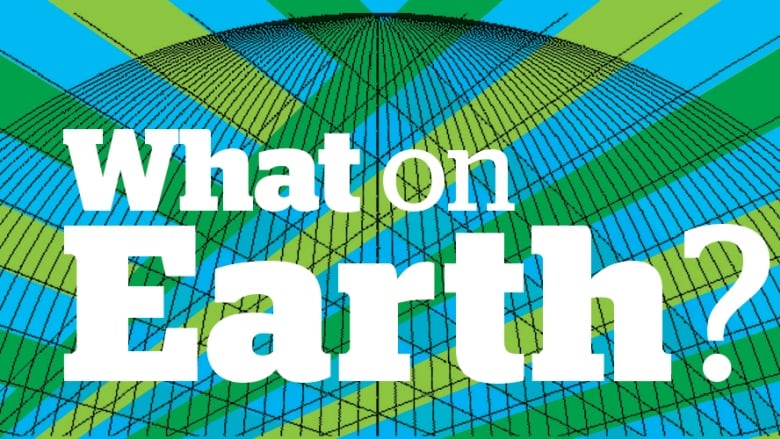Also: Hot enough for ya? 2023 shattered planetary heat records

Our planet is changing. So is our journalism. This weekly newsletter is part of a CBC News initiative entitled "Our Changing Planet" to show and explain the effects of climate change. Keep up with the latest news on our Climate and Environment page.
Sign up here to get this newsletter in your inbox every Thursday.
This week:
- Electric garbage trucks clean up in a variety of ways
- Hot enough for ya? 2023 shattered planetary heat records
- Carbon offsets are helping protect B.C.'s Great Bear Rainforest. Is that sustainable?
Electric garbage trucks clean up in a variety of ways

A new kind of EV is hitting the road in Canada.
In December, Peel Region in the Greater Toronto Area began pilot-testing its first electric garbage truck. That's roughly a year after the first pilot test of an electric garbage truck in Canada launched in Squamish, B.C.
Municipal officials in these two communities say electrifying waste collection won't just keep streets clean and cut greenhouse gas emissions but will also reduce air and noise pollution.
Before electrifying their whole garbage fleets, however, they need to see how the trucks perform for different kinds of waste in different conditions, and figure out the logistics of charging and maintenance.
Squamish Mayor Armand Hurford said the electric garbage truck in his city, which represents about one-fifth of the local waste collection fleet, runs four to six hours a day. He says it depends on the terrain, which can be quite hilly, and the temperature, which varies from below zero Celsius to the high 30s.
"It seems to be working well," said Hurford, who noted that the vehicle is quieter than its gas-guzzling counterparts. "Quieter in general is good for all of us — you know, cleaner and quieter."
Hurford joked that there isa downside — the loss of that rumbling, hissing last-minute warning for residents to put their garbage out.
Peel Region will be testing its electric truck for collection of garbage, recycling and organics on both dense urban streets and more rural routes. It's working with the Smart Freight Centre, a research network involving the Region of Peel, McMaster University, the University of Toronto and York University to study how much the truck reduces greenhouse gas emissions, along with charging and maintenance requirements, said Erwin Pascual, manager of waste planning for the Region of Peel.
"We're going to determine what our residents' reactions are to this new type of vehicle, if we can," said Pascual.
Both Squamish and Peel are testing waste vehicles made by U.S.-based Mack Trucks, although Squamish notes that the body of its truck was mounted at Labrie Automizer in Quebec.
But Canadian options are starting to become available.
Lion Electric, a company based in Saint-Jérôme, Que., has developed a small electric garbage truck suitable for use in urban areas with narrow streets, and hopes to launch a bigger, more conventional-sized garbage truck in 2025, equipped with the company's own Canadian-made battery.
Patrick Gervais, vice-president of truck and public affairs at Lion Electric, said garbage trucks are well-suited to electrification because they make lots of stops, which are opportunities to recharge the battery through regenerative braking.
He added that there are potential maintenance benefits that come with electrification of not just the vehicle's propulsion but other moving parts used to collect and handle the garbage. With non-electric technology, "they're made with hydraulics and they break down all the time and there's spills," he said.
Peel Region's waste contractor, Emterra, initiated the new pilot.
"[Emterra] came to us and said, 'Hey, we're thinking about purchasing and testing this vehicle. Is Peel interested?'" Pascual said. The region had already been requiring waste contractors to use compressed natural gas instead of diesel since 2014 to cut pollution and emissions. "So when this opportunity came up … we thought it was the next natural step for us," said Pascual.
In Squamish's case, the city took the lead. It put a requirement to pursue electric vehicles in its contract with GFL, the company that handles the city's waste collection. Hurford thinks there are similar opportunities for cities to be catalysts for climate-positive change.
"I really think that procurement is a very vital place to be looking at," he said, "and requiring your contracted services folks to really push the limit on what they can do."
— Emily Chung
Old issues of What on Earth? are here. The CBC News climate page is here.
Check out our podcast and radio show. This week: the environmental fallout of the wars in Gaza and Ukraine, and the climate case for demilitarization. What On Earth drops new podcast episodes every Wednesday and Saturday. You can find them on your favourite podcast app, or on demand at CBC Listen. The radio show airs Sundays at 11 a.m. ET, 11:30 a.m. in Newfoundland and Labrador.
Watch the CBC video series Planet Wonder featuring our colleague Johanna Wagstaffe here.
Reader feedback
John Kemp:
"Thank you for your articles and stories each week. I find so many of them helpful in understanding what we and our planet face. The food waste story was special as each of us has a part to play. I would never presume to tell anyone they weren't doing enough to preserve our planet, but do wish that most of them would pay closer attention."
Write us at whatonearth@cbc.ca.
Have a compelling personal story about climate change you want to share with CBC News? Pitch a First Person column here.
The Big Picture: 2023 shattered planetary heat records

After a year of record-breaking wildfires across Canada and thehottest temperature ever recorded on Earth, it likely comes as no surprise that 2023 was the hottest year on record. According to the European Union's Copernicus Climate Change Service (C3S), 2023 was 1.48 C warmer than the pre-industrial average from 1850-1900,beating 2016's record of 1.25 C.
As we continue to burn fossil fuels and pump greenhouse gases into the atmosphere, the planet keeps getting warmer. But the rapid jump in global temperatures in 2023 shocked even climate scientists. Last year "surprised all climate scientists: the sheer number of records that were broken, and how they were broken. They were broken by very large amounts," said Samantha Burgess, deputy director of the C3S.
"Our expectation was with this transition to El Niño, that it would be warmer than [2022]. But … we didn't think it would be as exceptional as it was."
Not everyone is surprised by last year's record warmth.
"The warming is within the range we expect from the combined effect of continued long-term warming, plus a boost from a major El Niño event," Michael Mann, a climate scientist and professor of earth and environmental science at the University of Pennsylvania, said in an email to CBC News.
NASA and NOAA will release their findings on the global climate on Friday. While there may be a slight variation in their numbers — as their methodology differs from that of C3S — it's likely they will be similar. And, ultimately, it's the continued upward trend that matters.
— Nicole Mortillaro
Hot and bothered: Provocative ideas from around the web
-
In 2023, carbon emissions in Germany hit a 70-year low, thanks in large part to reduced coal use.
-
The Narwhal has produced a beautiful photo essay on Indigenous-led farms that have cropped up in hydro corridors in Toronto.
- A story in The Lever, an investigative journalism site based in the U.S., looks at how lawyers for Big Oil are exploiting the country's First Amendment to defend spurious claims about the industry's impact on the environment.
Carbon offsets are helping protect B.C.'s Great Bear Rainforest. Is that sustainable?

The map on Ernie Tallio's computer screen showed a tangled mess of red lines and dots.
It was late September and Tallio, who manages the Guardian Watchmen program for the Nuxalk First Nation in Bella Coola, B.C., was demonstrating where his team worked the previous summer: travelling the maze of inlets and bays along this rugged coast.
Among their myriad tasks was helping distressed boaters, pulling in crab traps as part of an annual scientific survey and monitoring the coast for illegal fishing and hunting activity.
"We're the eyes and ears of the nation," Tallio said.
The Guardian Watchmen is an Indigenous-led conservation program in the Great Bear Rainforest, a 6.4-million-hectare swath of snow-capped mountains and towering conifers that stretches from central B.C. to the Alaskan panhandle.
Watchmen programs like Tallio's operate in seven communities along the coast and on Haida Gwaii, employing some 150 local Indigenous people. Unlike park rangers, however, whose salaries are paid for with tax dollars, Guardian Watchmen are partially funded by an unusual source: carbon offsets.
Offsets are a way to "cancel out" greenhouse gases spewed into the atmosphere elsewhere. They work by letting emitters (individuals, corporations or governments) fund and take credit for emissions reductions from a project done by another party.
In the case of the Great Bear Rainforest, the carbon offsets are being sold by Coastal First Nations — an alliance of nine First Nations along B.C.'s coast — in exchange for protecting forests that would otherwise have been logged.
It's a novel way to fund conservation — one that proponents hope could be a model for elsewhere. But to date, offset sales have been slower than expected, raising questions as to whether this unique model is actually sustainable.
The Great Bear Rainforest is considered one of the biggest carbon sinks in the world, sucking millions of tonnes of carbon dioxide from the atmosphere every year.
The unique funding model was developed as part of an agreement signed in 2016 by Coastal First Nations and the provincial government. Under the agreement, 85 per cent of the rainforest was declared off limits to logging, including 70 per cent of old-growth forests.
Selling offsets was seen as a way to counter the economic impact of reduced logging, said Paul Kariya, a senior policy analyst with Coastal First Nations. But to date, the annual revenue from carbon offsets has been only half of what had been expected. The B.C. government has been the main buyer, offsetting emissions from its public sector operations, including hospitals and universities.
Roughly $10 million of credits remain unsold each year, however, leaving programs like the Guardian Watchmen at risk.
"It's fair to say that the shingle was hung out and we were ready for business," said Kariya. "But it's not like the world has come knocking on our door."
One of the criticisms of the Great Bear Rainforest carbon offset project is that old-growth logging has continued despite the protection of more forested areas.
Jody Holmes, director of the Rainforest Solutions Project, says the value of carbon offsets is enough to slow second-growth logging, but not enough yet to save old-growth.
Still, she has seen a positive shift in how logging is done in the Great Bear Rainforest. Loggers are leaving bigger buffers along salmon-bearing streams and avoiding steep, unstable slopes, for example. The biggest change, Holmes says, has been a stronger recognition of First Nations values and culture.
"You have to work with the nations before you go out and do any logging now."
Public skepticism over the legitimacy of carbon offsets also remains high, fuelled by areport last year that Verra, the world's largest carbon credit certifier, was issuing "phantom credits" for projects in the Amazon rainforest.
Kariya says that around the time the Great Bear agreement was signed, the carbon offset market was flooded with cheap offsets for projects done elsewhere that lacked proper oversight. The result was a big dip in the price of carbon credits, to as low as $2 US per tonne of greenhouse gas emissions offset (the current price is around $15 per tonne).
Most of the Great Bear carbon offsets are sold through what's known as the "voluntary market" — individuals looking to reduce their carbon footprint or corporations that have voluntarily pledged to cut their emissions. The hope, Kariya says, is that more corporations will be required to cut their carbon emissions, which should drive more demand for offsets.
Kariya concedes that the idea of using carbon offsets to fund conservation is still relatively new in Canada. But he's optimistic it can be a sustainable model. He has been promoting the offset program at international events like Climate Week NYC in hopes of drumming up more sales.
"We're trying to tell our story," he said. "It's taken a little while to get going, but it's starting to take hold and grow."
— Brad Badelt
Stay in touch!
Are there issues you'd like us to cover? Questions you want answered? Do you just want to share a kind word? We'd love to hear from you. Email us at whatonearth@cbc.ca.
Sign up hereto get What on Earth? in your inbox every Thursday.
Editor: Andre Mayer | Logo design: Sködt McNalty

Add some “good” to your morning and evening.
A variety of newsletters you'll love, delivered straight to you.
*****
Credit belongs to : www.cbc.ca
 MaharlikaNews | Canada Leading Online Filipino Newspaper Portal The No. 1 most engaged information website for Filipino – Canadian in Canada. MaharlikaNews.com received almost a quarter a million visitors in 2020.
MaharlikaNews | Canada Leading Online Filipino Newspaper Portal The No. 1 most engaged information website for Filipino – Canadian in Canada. MaharlikaNews.com received almost a quarter a million visitors in 2020.







